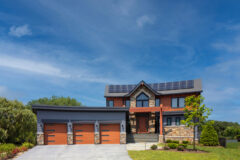Kipnis Architecture + Planning
Nathan Kpnis, FAIA, LEED BD+C is the founder of Chicago’s premier award winning sustainable architectural practice, Kipnis Architecture + Planning (KAP). It was founded in 1993 and it is based in Evanston, Illinois and Boulder, Colorado.
KAP has practiced the architectural design philosophy of ‘High Design/Low Carbon™’ long before it was in vogue. They have a particular expertise is the architectural integration of passive solar and bioclimatic design.
Stylistically, KAP’s designs are the creative synthesis of your wishes, the project’s sustainable and wellness goals, the site’s context and clients’ budget. They excel at modern, transitional, and historic aesthetics.
Share a little bit about yourself and what inspires you.
The influence

As a suburban kid, I dreamt of becoming an architect from a young age. In fourth grade, my art teacher encouraged me, sparking my passion. Growing up on Chicago’s North Shore, I was captivated by the impressive architecture around me. From traditional lakeside homes to sleek Mid Century Modern designs, and even towering city buildings, I was constantly inspired. In high school, I pursued skateboarding as a semi-professional, which allowed me to explore urban spaces in unique ways. It altered my perspective, encouraging me to envision alternative uses for every element, be it curbs, concrete slabs, or banked areas. Unbeknownst to me then, this viewpoint greatly benefits my architectural work.
How did you get started in the business?
Forward-looking
Since age six, I aspired to be an architect. The 1973 oil embargo and early solar panel homes fascinated me, sparking my interest in sustainable housing. I studied ‘Environmental Design’ and solar design at the University of Colorado, where I experienced a community dedicated to sustainability. In 1983, I pursued my Masters of Architecture at Arizona State University, specializing in Energy Conscious Design. It took time to promote sustainability in the industry, but by 1993, I incorporated sustainable and energy-efficient elements into homes without explicitly informing clients. In 1999, my project was chosen for the Green Homes for Chicago competition, marking a turning point in my sustainable design journey. Since then, I have actively advanced sustainable design and held various leadership roles in the American Institute of Architects (AIA). I currently serve on the executive committee of the AIA’s Small Firm Exchange, focusing on fostering sustainability, resilience, wellness, and social justice in small firms. Additionally, I established NextHaus Alliance™, an integrated design group that prioritizes sustainability, resilience, and wellness for high-end clients, collaborating with like-minded sponsors such as Valcucine
What current trends are you most excited about and why?
Low carbon resources
Every few years, new aspects of sustainable design emerge. Currently, I’m excited about the focus on embodied carbon and its significant impact on climate change. We’re making strides in reducing operational carbon, but the challenge now lies in minimizing the carbon footprint of construction and maintenance. Exploring carbon-sequestering materials like wood, straw bale, and lambswool insulation is promising.
A holistic approach to sustainable design is gaining traction, extending beyond buildings to communities and countries. With limited time to act, the transition towards electrification is crucial. The increasing adoption of electric vehicles, fully electric homes, and scaling up wind and solar power generation indicate progress.
Where do you get your inspiration from? Nature, where you live
Learning from humanity's architecture marvels
I draw inspiration from the movement of the sun throughout the day and how it can be captured in architecture. My fascination with this approach began in graduate school when I learned about the tomb at Abu Simbel for Pharaoh Ramesses II. The tomb’s design aligns with the sun’s path on Ramesses II’s birthday, creating a dramatic effect. We incorporate this concept into our designs, not to make clients feel like almighty Pharaohs, but to establish a connection with nature. It resonates with everyone. Additionally, I consciously consider the sun’s position in a space at different times of the year and day, subtly marking the seasons and the passage of time. In my perspective, while the building remains stationary, the sun transforms the three-dimensional space into a fourth dimension.
Is a low carbon or zero energy residential building in the Midwest possible?
Making a difference closer to home
Yes! We’ve achieved several low carbon or zero energy residential buildings in the Midwest. Currently, we have two homes on track for Passive House Certification, an extremely demanding energy efficiency standard. To meet this standard, the homes must be exceptionally airtight (ten times tighter than code), incorporate a ventilation system for fresh air, use triple glazed windows, rely on all-electric systems (HVAC, dryer, water heater, and induction cooktop), include a battery backup system and EV charging, and feature a large on-site solar PV system. These elements make the homes zero energy and zero carbon in terms of operational carbon. However, addressing embodied carbon, the other type of carbon, presents a greater challenge. We are in the early stages of exploring solutions and making progress with each project.
What do you do in your spare time?
Fun and work
In my spare time, I actively participate in cycling and skateboarding. Currently, I’m preparing for a six-day, 400-mile fundraising event called Climate Ride, supporting Illinois Green’s efforts for a sustainable built environment. Additionally, I’m excited about the construction of a nearby skatepark and considering getting a new skateboard.
What is it that you value when working with the Mobili Möbel team? A specific project?
Real benefits
When collaborating with the Mobili Möbel team, I highly value their exceptional combination of design prowess and technical expertise. Their Valcucine cabinets stand out as the most sustainable cabinets I’ve come across. In a video produced by Valcucine, they meticulously dismantle a set of cabinets, highlighting that around 99.5% of the materials used are recyclable. Moreover, they are stunning pieces of art, aligning perfectly with my firm’s philosophy of ‘High Design/Low Carbon™’.









